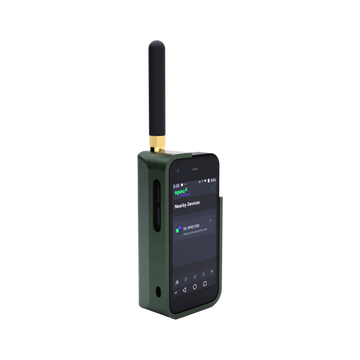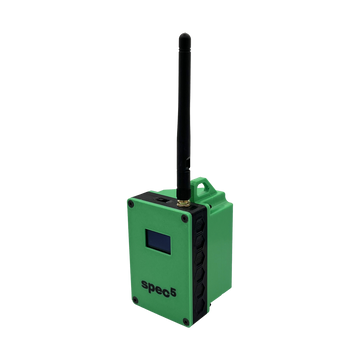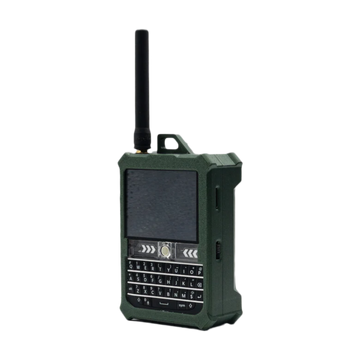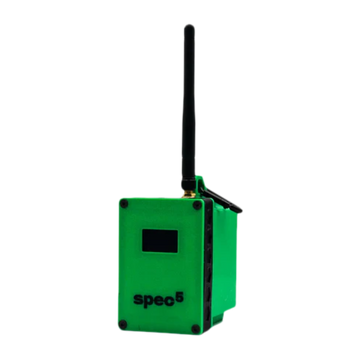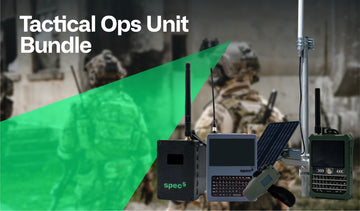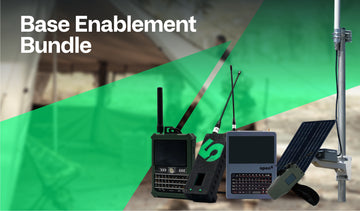In an increasingly connected world, mesh networking is emerging as the ultimate solution for seamless, robust, and scalable connectivity. Whether in the wildest landscapes, urban jungles, or during disaster recovery, mesh networks are transforming how we communicate by ensuring that connectivity remains reliable, uninterrupted, and secure. But why is mesh networking so critical as we move into 2025?
Mesh networking is a decentralized communication system in which each node (or device) in the network serves as both a sender and receiver of data, resulting in a self-healing, distributed network. This architecture increases network resilience by eliminating single points of failure, ensuring that communication can continue even if individual devices or nodes go offline. This is crucial in environments with unreliable infrastructure, such as remote areas, disaster zones, or tactical military operations.
‘’The beauty of mesh networking is that it’s built for resilience. If one link in the chain fails, the network finds another way to transmit data—like water finding a new path when a dam breaks.’’
This article explores why mesh networking is indispensable in 2025 and how SpecFive's innovative products enable reliable, secure communication for various use cases—from outdoor adventures and disaster relief to military operations. SpecFive's cutting-edge mesh devices enable users to stay connected even in the most challenging situations, providing seamless and scalable communication.
The Power of Mesh Networking for Seamless, Decentralized Connectivity
1. Resilient Communication
One of the most powerful advantages of mesh networking is its self-healing nature. In traditional networks, a failure in the central hub or a break in communication infrastructure can result in widespread disruption. However, in a mesh network, if a node fails or moves out of range, other nodes autonomously take over the transmission of data, ensuring seamless communication.
This capability ensures that the network remains uninterrupted even in challenging environments. In mission-critical situations like disaster recovery or military operations, the self-healing feature allows teams to continue communicating in real time, even if one or more devices go offline. Mesh networks provide robustness and stability that traditional systems cannot match because they eliminate the reliance on a single communication point.
2. High Coverage and Long-Range Connectivity
Traditional communication networks often struggle with coverage limitations, particularly in remote or rural areas. Mesh networks overcome these challenges by enabling nodes to pass data to neighboring devices, extending the range of the network and ensuring wide-area coverage. In essence, as long as nodes are within range of each other, data can travel across great distances, forming a robust communication grid.
This ability to extend coverage makes mesh networks ideal for use in mountainous terrain, dense forests, and other challenging environments. In these areas, where traditional networks typically fail, mesh networking continues to provide strong, uninterrupted communication. The long-range communication capabilities inherent in mesh networks ensure that reliable connectivity is available, even in some of the most remote locations on earth.
3. Decentralization and Flexibility
The decentralized architecture of mesh networks is another significant benefit. Mesh networks, as opposed to traditional systems that rely on a centralized infrastructure, spread communication obligations across several nodes. This minimizes the likelihood of system-wide failures and makes the network more adaptable and resilient. If one portion of the network fails, the system as a whole continues to function.
For tactical teams, first responders, and other field-based operations, mesh network decentralization implies increased autonomy and security. These teams can function independently of traditional infrastructure, which is critical during emergencies or hostile situations where communication links are at risk of being compromised. Mesh networks enable flexible adaptation to changing needs, ensuring reliable communication regardless of external influences.
4. Scalable and Adaptable Network Expansion
As mission requirements evolve, the ability to scale a network quickly is vital. Mesh networks excel in this regard because they can be expanded with ease—adding additional nodes to the network increases its capacity and range. This makes mesh networking particularly beneficial for situations where communication needs grow or change rapidly, such as in military operations, search-and-rescue missions, or scientific expeditions.
The scalability of mesh networks means that no matter how large or small the team, or how complex the operational area, the network can expand to fit the requirements. As devices are added, the network becomes more robust, allowing for increased coverage and bandwidth. This scalability also makes it easy to upgrade the network as demands grow without requiring major infrastructural changes.
5. Data Security and Privacy
In an era when data breaches are prevalent, security is a key factor for any communication system. Mesh networks are inherently secure since they function on a dispersed basis and send encrypted data from node to node. With end-to-end encryption and features like GPS disabling, mesh networking offers a level of privacy that traditional networks cannot provide.
For military units, tactical teams, and organizations handling sensitive data, security is paramount. Mesh networks deliver a decentralized, robust communication infrastructure that minimizes interception risks. With end-to-end encryption and access control, only authorized users can connect, ensuring the confidentiality and integrity of critical information. Mesh networks provide the ideal solution for high-security environments, offering reliable, tamper-proof communication when it matters most.
Real-World Use Cases for Mesh Networking in Remote and Off-Grid Locations
1. Outdoor Adventures and Off-Grid Communication
For outdoor enthusiasts, such as hikers, campers, and backpackers, maintaining reliable communication in remote areas can be difficult, as many traditional networks fail to provide coverage in these regions. Mesh networking provides a solution by enabling real-time communication even when there’s no cellular service. This capability is especially useful for groups of adventurers who want to stay connected and ensure their safety in isolated locations.
In areas where standard networks don’t reach, mesh networks create a self-sustaining communication grid, allowing participants to share location updates, send emergency alerts, and coordinate movements in the wilderness. The portability and reliability of mesh-enabled devices make them an invaluable tool for off-grid communication, ensuring that adventurers are never truly out of reach, even in the most remote areas.
2. Tactical and Military Operations
For military operations, secure, reliable communication is critical. Traditional communication infrastructure is often vulnerable to attack, interference, or failure, which can severely disrupt operations. Mesh networking provides a solution by allowing tactical units to create independent, self-healing networks that operate without relying on centralized communication hubs.
Each device within the network can communicate directly with others, ensuring that soldiers and units remain in contact even in remote or hostile environments. This network decentralization enhances security and flexibility, making it difficult for adversaries to disrupt communication by targeting a single point of failure. The ability to maintain continuous, real-time communication in even the most challenging conditions is a critical advantage for military personnel, especially in situations where cyberattacks and jamming are risks.
3. Emergency Response and Disaster Relief
In disaster recovery scenarios, traditional communication infrastructure is often among the first casualties. Cell towers, satellite links, and radio systems can become inoperable during natural disasters, leaving first responders without the means to coordinate efforts or communicate with each other. Mesh networking offers a powerful solution by enabling teams to set up ad-hoc communication grids that function independently of external infrastructure.
Mesh networks allow first responders to share critical information, coordinate rescue efforts, and maintain situational awareness during search-and-rescue operations. Whether in the aftermath of an earthquake, hurricane, or any other natural disaster, mesh networking ensures that communication remains operational, regardless of the condition of traditional networks.
4. Search and Rescue Operations
In search and rescue missions, every second matters. Mesh networking ensures reliable, real-time communication even in remote or disaster-stricken areas where traditional systems fail. Stay connected and act faster with mesh networks for seamless team coordination.
Mesh networks allow rescue teams to communicate and share real-time location updates while traversing vast areas. The self-healing nature of mesh systems ensures that communication is not interrupted, even if a team member moves out of range or a device fails. By setting up a local mesh grid, teams can operate autonomously, independent of centralized communication networks.
"Search and rescue missions rely on constant communication, and mesh networking ensures we stay connected, even when infrastructure is down."
5. Remote Scientific Research and Expeditions
Scientific expeditions, whether to the Arctic, Amazon, or the Himalayas, often take researchers into areas far from conventional communication infrastructure. In these environments, maintaining a secure, reliable communication channel is essential for coordinating efforts, sharing data, and ensuring the safety of the team.
Mesh networking allows scientific teams to establish a communication network without needing access to external infrastructure. With a self-sustaining mesh system, researchers can exchange data in real-time, share important findings, and stay in contact even when they are spread across large areas. The flexibility, scalability, and security of mesh networks make them ideal for remote research and expeditionary activities.
"The ability to communicate is vital in remote research—mesh networking ensures we can share data and coordinate, even in the most isolated parts of the worlD.’’
Why Choose SpecFive for Your Mesh Networking Needs?
When looking for a reliable mesh networking solution, SpecFive is a clear leader in the field. Their high-performance devices are engineered to deliver robust, secure, and scalable communication for a variety of use cases. Whether you're engaged in outdoor adventures, military operations, or emergency response, SpecFive's products provide reliable connectivity in even the most challenging environments.
- ATAK Integration: Easily integrate with apps like ATAK (Android Tactical Assault Kit) for real-time monitoring and secure communication.
- Long-Range Communication: SpecFive’s devices are optimized for long-range communication, ensuring reliable connectivity in remote and difficult-to-reach areas.
- Scalable Network: As your needs evolve, expanding your network is simple—add more devices to boost coverage and capacity with minimal setup.
- Data Security and Privacy: All communication is encrypted to ensure privacy and security, even in high-risk environments.
- Rugged and Portable: Built to withstand harsh conditions, SpecFive devices are durable, lightweight, and ready to perform in extreme environments.
SpecFive’s mesh networking solutions are future-proof and ready to meet the demands of 2025 and beyond, ensuring you remain connected when it matters most.
Conclusion
In 2025, mesh networking is no longer just a concept—it’s a necessity for reliable, secure, and scalable communication across a range of industries. From military operations to outdoor adventures and emergency response scenarios, mesh networks provide the resilience and flexibility needed to stay connected when traditional systems fail. As technology continues to advance, mesh networking will remain an essential tool for ensuring that communication is always possible—anywhere, anytime.
SpecFive provides highly reliable, secure, and scalable mesh networking devices that integrate seamlessly into complex environments without licenses and subscriptions. With built-in self-healing capabilities, high-level encryption, and low-latency data transmission, SpecFive’s mesh solutions ensure uninterrupted communication, whether you're navigating remote wilderness, handling a disaster recovery mission, or executing military tactics.
Choose SpecFive for secure, reliable mesh networking that delivers consistent, high-performance connectivity across diverse environments—without the need for cellular services or Wi-Fi.
FAQs
1. How does mesh networking improve communication in remote areas?
Mesh networking improves communication in remote areas by allowing devices to create a decentralized network that doesn't rely on central infrastructure. Each device in the network relays data to other devices, ensuring reliable communication even in areas where traditional cellular or Wi-Fi networks are unavailable.
2. Can mesh networking work in urban environments?
Yes, mesh networking can work in urban environments as well. In fact, it can help improve communication in dense urban areas by providing additional paths for data to travel, reducing congestion in traditional networks and providing a more reliable connection in crowded environments.
3. How secure is mesh networking?
Mesh networking can be highly secure. Many mesh networking devices, such as those from SpecFive, use encryption protocols to protect the data being transmitted. Additionally, the decentralized nature of mesh networks makes it harder for attackers to disrupt communication, as there is no single point of failure.

